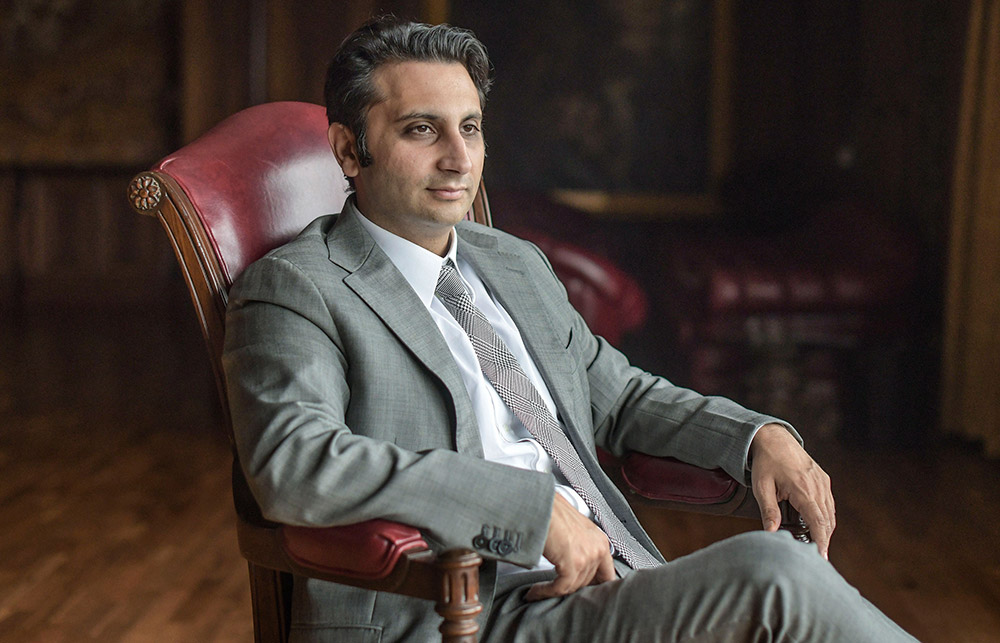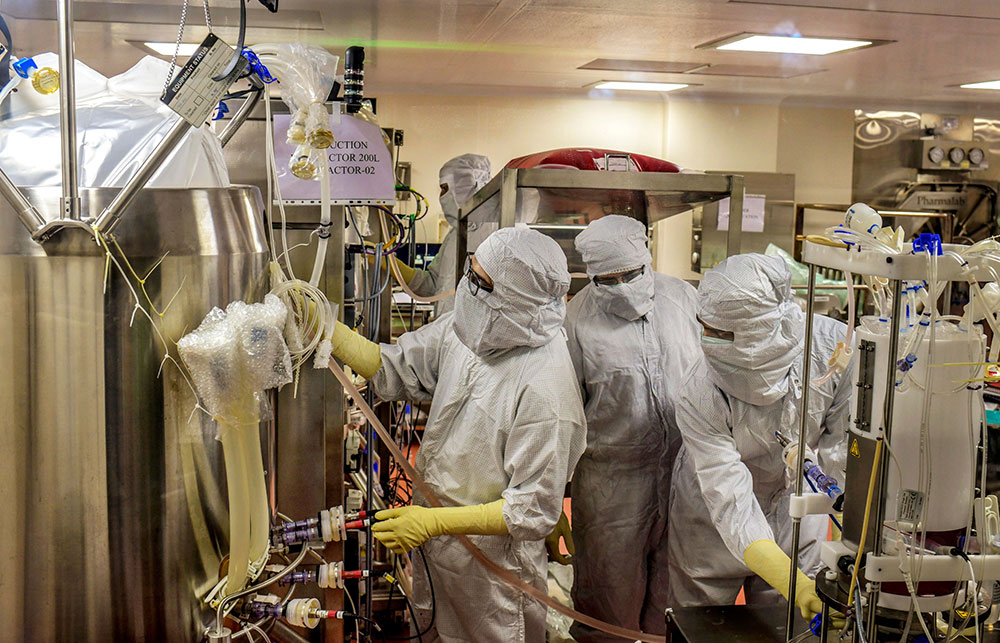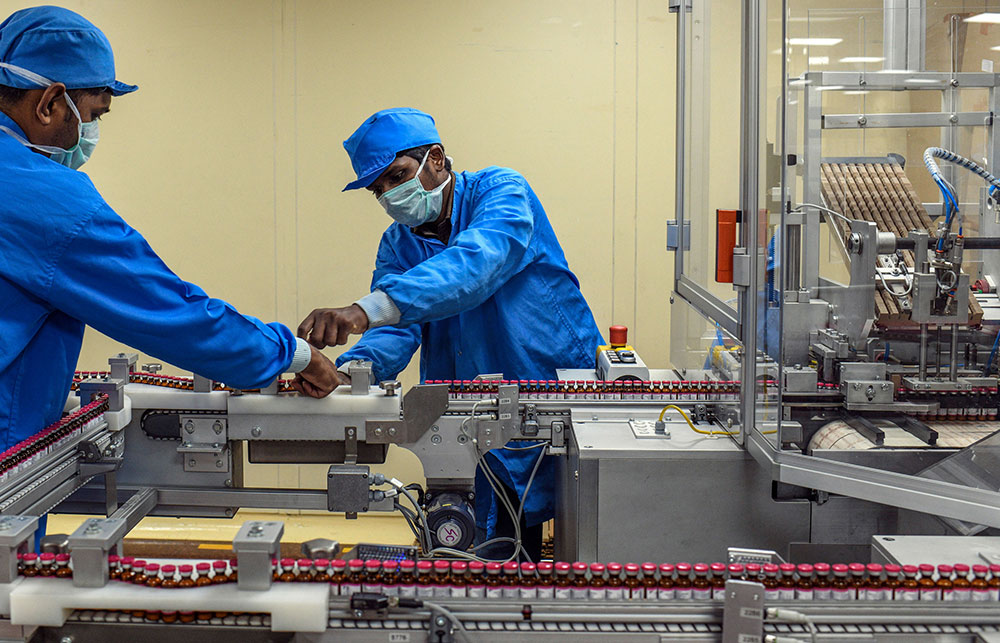与时间赛跑:印度血清研究所CEO谈新冠疫苗研发进展
从2012年起,阿达尔·波纳瓦拉开始担任印度血清研究所的负责人。这家所谓的研究所,实际上是他父亲1966年创办的一家医药公司,目前它已经成为全球最大的疫苗生产厂家。该公司年产疫苗约15亿支,其中的大部分都通过联合国儿童基金会和全球疫苗免疫联盟等国际组织和公益项目,提供给了广大中低收入国家的儿童。
这家公司以价格低廉的疫苗和庞大的接种规模而闻名。从今年年初开始,印度血清研究所再次成了新冠疫苗研发领域的重要玩家,对此,全球的医疗专家都觉得是一件再正常不过的事。该公司已经决定生产一两支目前看来最有希望的疫苗,同时公司内部也在研发自己的新冠疫苗。印度血清研究所在疫苗这一重要领域的一贯良好记录,也使它成功登上了《财富》杂志的“2020年改变世界的公司”榜单。

今年8月底,阿达尔·波纳瓦拉向《财富》杂志谈起了他的公司,以及新冠疫苗的研发工作。为清晰起见,以下采访稿有轻微删节。
《财富》:你现在一定很忙。你们是如何参与到抗击新冠疫情的工作中的?
阿达尔·波纳瓦拉:今年三四月的时候,世界卫生组织宣布,新冠肺炎已经形成全球大流行,这给我们敲响了警钟。我马上召集了公司的科学家开会。我们开始讨论,我们怎样才能在疫情中发挥作用?最终,疫苗将成为疫情的解决方案。作为全球最大的疫苗厂商之一的CEO,我们有责任采取行动,发挥重要作用,在这场可怕的疫情中保护人类。从那时开始,我采取了两项战略,一是研发我们自己的疫苗平台,它还需要一年半的时间才能完成三期试验。
后来,我听说牛津大学和诺瓦瓦克斯公司(Novavax)等杰出的科研机构和企业已经搞出了一支临床疫苗。我以前就跟这些人合作过,所以我决定再次跟他们合作。如果一支疫苗已经研发出来了,那么接下来最大的挑战就是生产它,然后将它分配到世界的每个一部分、每一个角落。在生产上,我没有听说有多少公司愿意牺牲利润丰厚的产品,在12月前生产新冠疫苗。虽然我没有听说有公司愿意这样做,但我觉得我有责任冒险一试。我们投入了几亿美元的资金购买原材料、建设产能——这笔投资现在已经达到4.5亿美元左右。我们现在已经是冒着风险在生产了,我们赌的就是这些疫苗在12月能成功。这就是我们现在的情况,也是为什么全世界都对我在印度做的这些事很感兴趣的原因。

你现在可以说是受到万众瞩目了,这种感觉怎么样?其他制药公司的情况如何?
所有人都很友好,乐于提供帮助和合作。我们与阿斯利康等几家大型制药企业也有合作。我不知道他们现在在想什么,但从我的角度看,我们一直都是很低调的。我估计美国甚至没有人听说过我们,因为我们是一家私营企业,而不是一家上市公司。现在全世界都在谈论我们,我们既感到震憾,也感到鼓励——我已经登上了舞台,现在我需要表演了。大家都期待和希望我能成功。这些美好愿望和积极的鼓励,和这种令人几乎有些恐慌的责任感,都使我感到重任在肩,鞭策着我每天快些做事。每天我都在想,我是不是忽略了什么?我能把事情做得更好、更快一些吗?因为我们是在和时间赛跑。起初,我在这个位置上还很有压力,因为坦率地说,我并不习惯这种情形。现在我已经习惯了,它甚至帮助和激励了我。
你们的新冠疫苗生产,对其他疫苗的生产有何影响?
一开始,我们做了很多调整,也感受到了很大的压力,因为我们不想影响到现有疫苗的供应。不过现在一切都井然有序,因为我们能够做好排产工作。我们每天已经增加到了三到四班排产,所以我们不需要做出任何妥协。因为孩子们接种其他疫苗也是同样重要的。大多数疫苗针对的疾病要远远比新冠病毒更加致命,比如肺炎。另外,如果儿童不接种轮状病毒疫苗,那么轮状病毒对儿童生命的威胁也将超过新冠病毒。
印度血清研究所是如何成为这么多国家的主要疫苗供应商的?
我父亲(赛勒斯·波纳瓦拉)在上世纪60年代创办了这家公司,他一直想从慈善和道德的角度为人类做些事。过去10年间,我们就是这样打入了全球疫苗免疫联盟的主要市场。现在,我们的疫苗已经进入了全球160多个国家。比尔和梅琳达·盖茨基金会认为,我们的战略定位非常适合弥补中低收入国家人民的疫苗缺口。随着时间的推移,在我接手公司以来,我也在新的需求增加之前,持续扩大了很多产能。
因此,即使在今天,我也能确保公司具备20亿支疫苗的产能。目前我们的产量只有14亿支。我一直在建设过剩产能,这不仅使我们成了联合国儿童基金会和全球疫苗免疫联盟最大的疫苗供应商,也让我们在疫情期间真正有机会使用到这些过剩产能。
你们生产的很多疫苗被全球疫苗免疫联盟和联合国儿童基金会等国际组织采购了。这项工作是如何开始的?
大概是在我参与公司经营之前10到15年之间的时候,当时我还在上学,我父亲和他的团队已经获得了世界卫生组织的预审资格,这说明你的产品已经达到了一种普遍认可的高质量标准。当他们来检查你,并且说你的疫苗已经符合药品生产质量管理规范时,全世界都会对你打开大门,各国都可以买你的产品,并且大家都觉得你的产品是安全的。这大概是上世纪八九十年代的事了。而当我参与公司经营时,我们的产品只进入了二三十个国家。我希望让印度血清研究所成为一个真正的全球级选手,于是我开始到各国注册产品,并且进一步与联合国儿童基金会和全球疫苗免疫联盟合作。我们当时已经与他们有合作了,我只不过是进一步加深了这种合作。

多年以来,很多制药企业都与印度血清研究所合作生产新型的廉价疫苗,比如用于预防A型脑膜炎的MenAfriVac疫苗。你能谈谈这方面的工作吗?
非洲是很需要这个产品的,但没有人愿意以每支疫苗30到40美分的价格去生产它。而我们的产品当时只卖25美分到30美分一支,现在大概也只有50美分一支。对于任何一家制药公司来说,生产一种售价还不到1美元的产品都是不划算的,尤其是疫苗。在那以后,我们又生产了轮状病毒疫苗和肺炎球菌疫苗,也都是以极低的价格生产的。只有在联合国儿童基金会和全球疫苗免疫联盟鼓励我们生产廉价疫苗,并且积极与我们合作,向那些不知如何获得低成本疫苗的国家推广这些疫苗的情况下,我们才可以一直这样做。
你是如何以如此之低的成本生产和销售疫苗的?
我刚刚和别人聊过这个话题,他们问我:“你明明可以把价格定得比现在高很多,有钱为什么不赚呢?”我说:“你看,我不缺钱花,我已经很有钱了,我不需要额外的利润。我相信盈利,不相信暴利。”我也不想非议那些大型制药公司,他们有股东,需要增长。而我能接受较低的增长率和利润率,只要我能确保公司发展、确保再投资扩大产能和革新技术、获得一个健康的利润。除此之外,我并不贪心,而且我感到很满足。这就是为什么我能做到那些事。当然,另一个因素是印度的生产成本较低。虽然印度的成本低,但我在欧洲也有一家公司,有40英亩的厂区,我在那里主要生产脊髓灰质炎疫苗,所以我也了解欧洲的生产成本,它可能要比我们高30%到40%。但仅仅因为我的成本高了30%到40%,不代表我就有理由把价格提高五六倍。这只取决于你的管理风格、你的喜好,以及你想变得多贪婪。这就是我的看法,也是过去9年间我经营公司的方式。
你提到了你父亲的人道主义理念和他的“公益性定价”的理念。你对公司的经营理念也与他一脉相传吗?
我们的理念非常相似。这是我们内心里非常接近的部分。我也创办了一两家规模小一些的企业,但疫苗是我的骄傲、我的乐趣和我的激情所在,因为我知道,做这件事情能挽救很多人的生命,特别是婴幼儿的生命。还有什么比这更重要、更让人满足的呢?这个目标一直吸引着我。其他公司也提供服务,他们也赚了钱,但归根结底,你真正做了什么呢?我经常说,如果我做生意,它就必须着眼于让别人生活得更好。所以从大学毕业后,我就直接进入了这个行业,扩展了公司,并且开始生产新的疫苗,这是一个自然而然的过程。
目前,我们正在研发世界上最好的疟疾疫苗。通过与牛津大学的合作,这种疫苗已经在非洲表现出很好的效果。目前它已经进入了二期研究。这些都是我真正热爱的事情。
印度血清研究所的业务经历了哪些重大的转折点?
我认为,在过去10年里,我们证明了我们自己已经具备了研发疫苗的能力,比如肺炎疫苗,这就是一个转折点,因为我们已经从一个纯粹的生产者进化成了一个发明者和研发者。这是非常重要的。当然,随着2012年我们收购了一家荷兰的公司,业界已经将我们视为一家全球性的生产商,而不仅仅是一家印度公司。2017年,我们又收购了捷克的一家公司。现在,我们在两个大洲的几个国家、几个工厂都有疫苗生产。我们在印度也有三家工厂。
这些转折点都需要大量的前期投资吧?
疫情爆发以来,为了获得一些现金,我们已经将那家捷克工厂卖给了诺瓦瓦克斯公司。就在三个月前,我们把它以1.67亿美元卖了出去,因为我需要更多资金拓展印度产能和生产新冠肺炎疫苗。而诺瓦瓦克斯公司也希望利用那家捷克工厂生产新冠肺炎疫苗,所以双方可以说是不谋而合。我们在荷兰还有40亩地的工厂,我们在那里生产着很多疫苗。我的欧洲和美国市场的战略基本都依靠那里。
你介绍了很多短期的情况。你认为10年后,印度血清研究所会是什么样子?
这很难说。我想会有很多新玩家入局。我已经看到了很多新的疫苗厂家的出现,但生产疫苗是一个高度专业化和困难的过程。这就是为什么全球目前只有五六家大型疫苗厂商。疫苗不像普通的药物那么简单。但我认为,这种情况迟早会发生改变。如果我还想在疫苗行业继续立足,就必须更加积极进取。我必须研发和推出大量的疫苗,才能保持在业界的主导地位。我认为这种变化将在未来十年内发生。
你认为未来的竞争会主要来自印度吗?
不仅仅是印度。所有大国都有生产疫苗的能力,只不过长期以来一直忽视了疫苗。另外,出于国家安全考虑,每个大国可能都想拥有自己的疫苗工厂,甚至是国有的疫苗工厂。因为他们不想在陷入这样的疫情危机时,只能依赖印度、中国、巴西或者是天知道哪里的公司来提供疫苗。他们肯定是想自己来做的。至于他们会多认真地对待这个问题,就让我们拭目以待吧。
你认为疫苗的地位会因为当前的情况而改变吗?
我认为,现在很多人都会相信疫苗的作用和重要性了。以前对于应不应该接种疫苗,很多人都是犹豫不决的。但现在大家都看清楚了,比起住院、病死或者得重病,你只需要打一针疫苗,它就能保护你。很多怀疑论者现在都安静下来了。我已经看到了这种变化。
但不管疫苗是在今年还是明年问世,它都不是一种能够彻底解决疫情的灵丹妙药,我认为所有人都要明白这一点。因为疫苗的有效性可能只有50%、70%或者80%。也就是说,很多接种了疫苗的人仍然有可能感染,并且传染其他人。随着大家都接种了疫苗,由于群体免疫效应,新冠肺炎的传染范围和确诊病例数肯定会有所下降,但这并不是结束。我想把这一点指出来。因为可能有人会想,一旦疫苗来了,疫情就结束了。这种想法是非常危险的,否则就会有人接种了疫苗后到处乱跑,而且不采取任何防范措施,因为他们觉得自己无敌了。这种心态是弊大于利的。现在大家都乐观地认为,疫苗有可能在接下来的一两个季度里面世,但在当前情况下指出这一点是很有必要的。
很多公司都在研究新冠肺炎疫苗。如果他们来找你,你会跟他们合作吗?
现在我们已经快忙不过来了,因为我已经有五支新冠肺炎疫苗了。我不认为有人在同时搞五种新冠疫苗,大多数公司只有一两种。“贪多嚼不烂”。诺瓦瓦克斯和阿斯利康都已经进入了三期试验阶段,所以我们的疫苗有可能会在11月或者12月推出。
我可能也不会考虑任何中国或俄罗斯的疫苗,这仅仅是出于数据透明度的考虑。你不知道你能从这些产品中得到什么,所以我对生产它们在道德上没有信心。也许在我们看到那些公司的更多数据之后,我们会研究它,但现在不会。我现在不再接受任何更多的合作了。
能给我们讲讲你们正在研发的新冠肺炎疫苗吗?
它们是一种减毒活疫苗,也就是说病毒经过减毒除理,毒性减弱了,但仍然保持了病毒的抗原性。在防治麻疹等传染性疾病上,减毒活疫苗历来是最强大、最有效的疫苗,而且它能长期对你形成保护,这也是一个非常重要的因素。你不想在接种疫苗两年后,发现你又成了新冠肺炎的易感人群,对吧?这就像每年注射一次流感疫苗,既费钱又不实际。因此,我宁可花两年以上的时间来研发我们的疫苗,我希望我们的疫苗能像麻疹疫苗一样强大,能给你长期的免疫力和很高的保护水平,比如保持90%到95%的有效性。这就是为什么我要慢慢来、不着急。但全球也同样需要应急的产品,所有人都在这方面施加压力,所以我很早就决定,与在这方面领先的人开展合作。(财富中文网)
译者:朴成奎
从2012年起,阿达尔·波纳瓦拉开始担任印度血清研究所的负责人。这家所谓的研究所,实际上是他父亲1966年创办的一家医药公司,目前它已经成为全球最大的疫苗生产厂家。该公司年产疫苗约15亿支,其中的大部分都通过联合国儿童基金会和全球疫苗免疫联盟等国际组织和公益项目,提供给了广大中低收入国家的儿童。
这家公司以价格低廉的疫苗和庞大的接种规模而闻名。从今年年初开始,印度血清研究所再次成了新冠疫苗研发领域的重要玩家,对此,全球的医疗专家都觉得是一件再正常不过的事。该公司已经决定生产一两支目前看来最有希望的疫苗,同时公司内部也在研发自己的新冠疫苗。印度血清研究所在疫苗这一重要领域的一贯良好记录,也使它成功登上了《财富》杂志的“2020年改变世界的公司”榜单。
今年8月底,阿达尔·波纳瓦拉向《财富》杂志谈起了他的公司,以及新冠疫苗的研发工作。为清晰起见,以下采访稿有轻微删节。
《财富》:你现在一定很忙。你们是如何参与到抗击新冠疫情的工作中的?
阿达尔·波纳瓦拉:今年三四月的时候,世界卫生组织宣布,新冠肺炎已经形成全球大流行,这给我们敲响了警钟。我马上召集了公司的科学家开会。我们开始讨论,我们怎样才能在疫情中发挥作用?最终,疫苗将成为疫情的解决方案。作为全球最大的疫苗厂商之一的CEO,我们有责任采取行动,发挥重要作用,在这场可怕的疫情中保护人类。从那时开始,我采取了两项战略,一是研发我们自己的疫苗平台,它还需要一年半的时间才能完成三期试验。
后来,我听说牛津大学和诺瓦瓦克斯公司(Novavax)等杰出的科研机构和企业已经搞出了一支临床疫苗。我以前就跟这些人合作过,所以我决定再次跟他们合作。如果一支疫苗已经研发出来了,那么接下来最大的挑战就是生产它,然后将它分配到世界的每个一部分、每一个角落。在生产上,我没有听说有多少公司愿意牺牲利润丰厚的产品,在12月前生产新冠疫苗。虽然我没有听说有公司愿意这样做,但我觉得我有责任冒险一试。我们投入了几亿美元的资金购买原材料、建设产能——这笔投资现在已经达到4.5亿美元左右。我们现在已经是冒着风险在生产了,我们赌的就是这些疫苗在12月能成功。这就是我们现在的情况,也是为什么全世界都对我在印度做的这些事很感兴趣的原因。
你现在可以说是受到万众瞩目了,这种感觉怎么样?其他制药公司的情况如何?
所有人都很友好,乐于提供帮助和合作。我们与阿斯利康等几家大型制药企业也有合作。我不知道他们现在在想什么,但从我的角度看,我们一直都是很低调的。我估计美国甚至没有人听说过我们,因为我们是一家私营企业,而不是一家上市公司。现在全世界都在谈论我们,我们既感到震憾,也感到鼓励——我已经登上了舞台,现在我需要表演了。大家都期待和希望我能成功。这些美好愿望和积极的鼓励,和这种令人几乎有些恐慌的责任感,都使我感到重任在肩,鞭策着我每天快些做事。每天我都在想,我是不是忽略了什么?我能把事情做得更好、更快一些吗?因为我们是在和时间赛跑。起初,我在这个位置上还很有压力,因为坦率地说,我并不习惯这种情形。现在我已经习惯了,它甚至帮助和激励了我。
你们的新冠疫苗生产,对其他疫苗的生产有何影响?
一开始,我们做了很多调整,也感受到了很大的压力,因为我们不想影响到现有疫苗的供应。不过现在一切都井然有序,因为我们能够做好排产工作。我们每天已经增加到了三到四班排产,所以我们不需要做出任何妥协。因为孩子们接种其他疫苗也是同样重要的。大多数疫苗针对的疾病要远远比新冠病毒更加致命,比如肺炎。另外,如果儿童不接种轮状病毒疫苗,那么轮状病毒对儿童生命的威胁也将超过新冠病毒。
印度血清研究所是如何成为这么多国家的主要疫苗供应商的?
我父亲(赛勒斯·波纳瓦拉)在上世纪60年代创办了这家公司,他一直想从慈善和道德的角度为人类做些事。过去10年间,我们就是这样打入了全球疫苗免疫联盟的主要市场。现在,我们的疫苗已经进入了全球160多个国家。比尔和梅琳达·盖茨基金会认为,我们的战略定位非常适合弥补中低收入国家人民的疫苗缺口。随着时间的推移,在我接手公司以来,我也在新的需求增加之前,持续扩大了很多产能。
因此,即使在今天,我也能确保公司具备20亿支疫苗的产能。目前我们的产量只有14亿支。我一直在建设过剩产能,这不仅使我们成了联合国儿童基金会和全球疫苗免疫联盟最大的疫苗供应商,也让我们在疫情期间真正有机会使用到这些过剩产能。
你们生产的很多疫苗被全球疫苗免疫联盟和联合国儿童基金会等国际组织采购了。这项工作是如何开始的?
大概是在我参与公司经营之前10到15年之间的时候,当时我还在上学,我父亲和他的团队已经获得了世界卫生组织的预审资格,这说明你的产品已经达到了一种普遍认可的高质量标准。当他们来检查你,并且说你的疫苗已经符合药品生产质量管理规范时,全世界都会对你打开大门,各国都可以买你的产品,并且大家都觉得你的产品是安全的。这大概是上世纪八九十年代的事了。而当我参与公司经营时,我们的产品只进入了二三十个国家。我希望让印度血清研究所成为一个真正的全球级选手,于是我开始到各国注册产品,并且进一步与联合国儿童基金会和全球疫苗免疫联盟合作。我们当时已经与他们有合作了,我只不过是进一步加深了这种合作。
多年以来,很多制药企业都与印度血清研究所合作生产新型的廉价疫苗,比如用于预防A型脑膜炎的MenAfriVac疫苗。你能谈谈这方面的工作吗?
非洲是很需要这个产品的,但没有人愿意以每支疫苗30到40美分的价格去生产它。而我们的产品当时只卖25美分到30美分一支,现在大概也只有50美分一支。对于任何一家制药公司来说,生产一种售价还不到1美元的产品都是不划算的,尤其是疫苗。在那以后,我们又生产了轮状病毒疫苗和肺炎球菌疫苗,也都是以极低的价格生产的。只有在联合国儿童基金会和全球疫苗免疫联盟鼓励我们生产廉价疫苗,并且积极与我们合作,向那些不知如何获得低成本疫苗的国家推广这些疫苗的情况下,我们才可以一直这样做。
你是如何以如此之低的成本生产和销售疫苗的?
我刚刚和别人聊过这个话题,他们问我:“你明明可以把价格定得比现在高很多,有钱为什么不赚呢?”我说:“你看,我不缺钱花,我已经很有钱了,我不需要额外的利润。我相信盈利,不相信暴利。”我也不想非议那些大型制药公司,他们有股东,需要增长。而我能接受较低的增长率和利润率,只要我能确保公司发展、确保再投资扩大产能和革新技术、获得一个健康的利润。除此之外,我并不贪心,而且我感到很满足。这就是为什么我能做到那些事。当然,另一个因素是印度的生产成本较低。虽然印度的成本低,但我在欧洲也有一家公司,有40英亩的厂区,我在那里主要生产脊髓灰质炎疫苗,所以我也了解欧洲的生产成本,它可能要比我们高30%到40%。但仅仅因为我的成本高了30%到40%,不代表我就有理由把价格提高五六倍。这只取决于你的管理风格、你的喜好,以及你想变得多贪婪。这就是我的看法,也是过去9年间我经营公司的方式。
你提到了你父亲的人道主义理念和他的“公益性定价”的理念。你对公司的经营理念也与他一脉相传吗?
我们的理念非常相似。这是我们内心里非常接近的部分。我也创办了一两家规模小一些的企业,但疫苗是我的骄傲、我的乐趣和我的激情所在,因为我知道,做这件事情能挽救很多人的生命,特别是婴幼儿的生命。还有什么比这更重要、更让人满足的呢?这个目标一直吸引着我。其他公司也提供服务,他们也赚了钱,但归根结底,你真正做了什么呢?我经常说,如果我做生意,它就必须着眼于让别人生活得更好。所以从大学毕业后,我就直接进入了这个行业,扩展了公司,并且开始生产新的疫苗,这是一个自然而然的过程。
目前,我们正在研发世界上最好的疟疾疫苗。通过与牛津大学的合作,这种疫苗已经在非洲表现出很好的效果。目前它已经进入了二期研究。这些都是我真正热爱的事情。
印度血清研究所的业务经历了哪些重大的转折点?
我认为,在过去10年里,我们证明了我们自己已经具备了研发疫苗的能力,比如肺炎疫苗,这就是一个转折点,因为我们已经从一个纯粹的生产者进化成了一个发明者和研发者。这是非常重要的。当然,随着2012年我们收购了一家荷兰的公司,业界已经将我们视为一家全球性的生产商,而不仅仅是一家印度公司。2017年,我们又收购了捷克的一家公司。现在,我们在两个大洲的几个国家、几个工厂都有疫苗生产。我们在印度也有三家工厂。
这些转折点都需要大量的前期投资吧?
疫情爆发以来,为了获得一些现金,我们已经将那家捷克工厂卖给了诺瓦瓦克斯公司。就在三个月前,我们把它以1.67亿美元卖了出去,因为我需要更多资金拓展印度产能和生产新冠肺炎疫苗。而诺瓦瓦克斯公司也希望利用那家捷克工厂生产新冠肺炎疫苗,所以双方可以说是不谋而合。我们在荷兰还有40亩地的工厂,我们在那里生产着很多疫苗。我的欧洲和美国市场的战略基本都依靠那里。
你介绍了很多短期的情况。你认为10年后,印度血清研究所会是什么样子?
这很难说。我想会有很多新玩家入局。我已经看到了很多新的疫苗厂家的出现,但生产疫苗是一个高度专业化和困难的过程。这就是为什么全球目前只有五六家大型疫苗厂商。疫苗不像普通的药物那么简单。但我认为,这种情况迟早会发生改变。如果我还想在疫苗行业继续立足,就必须更加积极进取。我必须研发和推出大量的疫苗,才能保持在业界的主导地位。我认为这种变化将在未来十年内发生。
你认为未来的竞争会主要来自印度吗?
不仅仅是印度。所有大国都有生产疫苗的能力,只不过长期以来一直忽视了疫苗。另外,出于国家安全考虑,每个大国可能都想拥有自己的疫苗工厂,甚至是国有的疫苗工厂。因为他们不想在陷入这样的疫情危机时,只能依赖印度、中国、巴西或者是天知道哪里的公司来提供疫苗。他们肯定是想自己来做的。至于他们会多认真地对待这个问题,就让我们拭目以待吧。
你认为疫苗的地位会因为当前的情况而改变吗?
我认为,现在很多人都会相信疫苗的作用和重要性了。以前对于应不应该接种疫苗,很多人都是犹豫不决的。但现在大家都看清楚了,比起住院、病死或者得重病,你只需要打一针疫苗,它就能保护你。很多怀疑论者现在都安静下来了。我已经看到了这种变化。
但不管疫苗是在今年还是明年问世,它都不是一种能够彻底解决疫情的灵丹妙药,我认为所有人都要明白这一点。因为疫苗的有效性可能只有50%、70%或者80%。也就是说,很多接种了疫苗的人仍然有可能感染,并且传染其他人。随着大家都接种了疫苗,由于群体免疫效应,新冠肺炎的传染范围和确诊病例数肯定会有所下降,但这并不是结束。我想把这一点指出来。因为可能有人会想,一旦疫苗来了,疫情就结束了。这种想法是非常危险的,否则就会有人接种了疫苗后到处乱跑,而且不采取任何防范措施,因为他们觉得自己无敌了。这种心态是弊大于利的。现在大家都乐观地认为,疫苗有可能在接下来的一两个季度里面世,但在当前情况下指出这一点是很有必要的。
很多公司都在研究新冠肺炎疫苗。如果他们来找你,你会跟他们合作吗?
现在我们已经快忙不过来了,因为我已经有五支新冠肺炎疫苗了。我不认为有人在同时搞五种新冠疫苗,大多数公司只有一两种。“贪多嚼不烂”。诺瓦瓦克斯和阿斯利康都已经进入了三期试验阶段,所以我们的疫苗有可能会在11月或者12月推出。
我可能也不会考虑任何中国或俄罗斯的疫苗,这仅仅是出于数据透明度的考虑。你不知道你能从这些产品中得到什么,所以我对生产它们在道德上没有信心。也许在我们看到那些公司的更多数据之后,我们会研究它,但现在不会。我现在不再接受任何更多的合作了。
能给我们讲讲你们正在研发的新冠肺炎疫苗吗?
它们是一种减毒活疫苗,也就是说病毒经过减毒除理,毒性减弱了,但仍然保持了病毒的抗原性。在防治麻疹等传染性疾病上,减毒活疫苗历来是最强大、最有效的疫苗,而且它能长期对你形成保护,这也是一个非常重要的因素。你不想在接种疫苗两年后,发现你又成了新冠肺炎的易感人群,对吧?这就像每年注射一次流感疫苗,既费钱又不实际。因此,我宁可花两年以上的时间来研发我们的疫苗,我希望我们的疫苗能像麻疹疫苗一样强大,能给你长期的免疫力和很高的保护水平,比如保持90%到95%的有效性。这就是为什么我要慢慢来、不着急。但全球也同样需要应急的产品,所有人都在这方面施加压力,所以我很早就决定,与在这方面领先的人开展合作。(财富中文网)
译者:朴成奎
Since 2012, Adar Poonawalla has headed the Serum Institute of India, the company his father founded in 1966 and which has grown into the world’s largest manufacturer of vaccines. The company produces roughly 1.5 billion doses a year, most of which go to immunize children in low- and middle-income countries through programs administered by organizations like Unicef and GAVI, the Vaccine Alliance.
The company is known for its low-cost production and enormous scale, and few global health experts were surprised earlier this year when the Serum Institute emerged as a key player in the COVID-19 vaccine race—signing on to manufacture a couple of the leading candidates, while developing a few of its own candidates internally. The company’s strong track record in this vitally important field earned it a slot on Fortune’s 2020 Change the World list.
Adar Poonawalla spoke with Fortune about that work and the company in late August. The interview has been edited lightly for clarity and length.
Fortune: It’s a busy time for you. How did you get involved in the COVID efforts?
Adar Poonawalla: If we rewind to March or April, when the [World Health Organization] announced to the world that this is something that will spread and go to every country and it’s a pandemic, that was a wake-up call. I called a meeting with my scientists. We started talking: How can we play a role in this? Ultimately, a vaccine is going to be the solution to the pandemic, and being one of the largest manufacturers in the world, I felt as a CEO that it was almost our responsibility to take action and do something and have a major role in trying to protect humanity from this terrible disease. That’s when it started. I took two strategies on board: One was to develop our own vaccine platforms, which is going to take about another year and a half to complete Phase III trials.
Then, I was hearing about Oxford [University] and Novavax, and all these great institutions and companies that already had a vaccine in the clinic. I knew these guys from past partnerships, so I decided to partner with them. If a vaccine is ready, the next biggest challenge is to manufacture it. And the third challenge is to distribute it to every corner in every part of the world. For the second challenge of manufacturing, I didn’t hear many other companies coming forward to sacrifice their lucrative products and manufacture a COVID vaccine come December. When I didn’t hear that, I almost felt it was a responsibility for me to take that plunge and invest hundreds of millions of dollars—now the figure is somewhere around $450 million—in building capacity and buying all the raw materials to gear up and be ready. We’ve already gone into production at risk, betting on these vaccines to succeed come December. That’s where we are at right now. And that’s why the world has taken a lot of interest in what I’ve been doing here in India.
You’re under a spotlight right now, What’s that like? What’s the dynamic like with other pharma companies?
Everyone is being very friendly and helpful and collaborative. We’ve got partnerships with a couple of large pharmaceutical companies like AstraZeneca. I don’t know what they must be thinking but from my angle, we were always very low key. I don’t think anyone in the United States had even heard about us, because we’re a privately listed company, not a publicly traded company. When all this international talk about us came, it kind of hit me and encouraged me further—I’m really on the spot now, and I need to perform. People are counting on me to succeed and hoping that I succeed. Those good wishes and positive encouragement, and a kind of sense of almost scary responsibility that I kind of feel I’m carrying on my shoulders, that is driving me every day to do things quicker. And every day, I’m thinking, Am I missing something? Can I do something better or faster? Because we’re racing against the clock. Initially, it was very stressful to be in that position because I wasn’t used to that, quite frankly, and now I’m very used to it. In fact, it has helped and motivated me.
How does your COVID vaccine manufacturing affect production of the other vaccines you produce?
Initially, there was a lot of rejigging and stress because we didn’t want to default on supplies of existing vaccines. Now everything is in order where we’re able to manage shifts. We’ve increased to three or four shifts in a day. That way we can manage everything without compromise. It’s equally important that kids get all the other vaccines. Most of them [protect against] bigger killers than COVID, like pneumonia. Rotavirus kills more children and will kill more children if they’re not vaccinated than COVID.
How did the Serum Institute become the main supplier of vaccines to so many countries around the world?
My father [Cyrus Poonawalla], who founded the company in the ’60s, was always wanting to do something for humanity in a very philanthropic and ethically priced manner. That’s how we made an entry into all these GAVI markets over the past 10 years. The Bill & Melinda Gates Foundation found us strategically positioned to cater to the gap that was there, and that was the affordability of these vaccines that were just not available to the masses in the 160-odd countries that we’re in today. As time went on, and as I sort of took over the business, I kept adding a lot of capacity ahead of demand.
As a result, even today, I could make 2 billion doses in my facility. I only make 1.4 billion. I kept building the excess capacity, which not only made me the biggest supplier of vaccines to Unicef and GAVI in the past 10 years but also gave us this excess capacity that we can really now use in the COVID crisis.
Many of the vaccines you produce are purchased by organizations like GAVI and Unicef. How did that work start?
About 10 or 15 years before I joined the business, I was still in school in those days, my father and his team at that time received the WHO prequalification which [means your product meets] a kind of universal good quality standard. When they inspect you and certify you to say that you make GMP—good manufacturing practices—vaccines, the world becomes open to you, and countries can buy your product and feel safe buying your product. It was at that point in the ’80s and ’90s I’d say that happened. We slowly entered more countries. When I joined the business, we were only in about 20 or 30 countries. I wanted to make Serum Institute a truly global player, which is when I went out to the world to really register the products in all these other countries and further engaged with Unicef and GAVI to get my products out there. We already had that relationship at that time, and then I just engaged further.
The Serum Institute of India has been recognized over the years for its partnerships to produce new, low-cost vaccines like MenAfriVac for meningitis A. Can you tell me about that work?
Africa needed this product, and nobody wanted to make it at 30 to 40 cents a dose. We launched it, I think, at something like 25 to 30 cents in those days, and now it’s maybe 50 cents a dose. It wasn’t really worthwhile for any pharmaceutical company to make a product, especially a vaccine at less than $1. After that, we got rotavirus vaccines, pneumococcal vaccines, again, at very, very low prices. It was only natural that Unicef and GAVI, you know, encouraged and worked with us to offer the product to all these other countries who didn’t know how to get access to lower-cost vaccines.
How is that you can produce and sell vaccines at such a low cost?
I was just talking to someone else, and they were asking me, “Why do you leave money on the table when you could charge far higher prices?” I said, “Look, I’m well-to-do. I’m fairly wealthy. I don’t need extra profits. I believe in profit making but not profiteering.” I don’t want to speak against the larger pharmaceutical companies. They have shareholders, and they need to grow. I’m happy with a lower growth rate and a lower profit margin, as long as I can do what I need to do in terms of expanding, reinvesting in capacity and technology, and making a healthy profit. I’m not greedy beyond the point, and I’m quite satisfied. That’s why I’m able to do what I’m able to do. Of course, the other factor is operating at my scale with costs in India. Certainly the costs are low, but I have a company in Europe, a 40-acre campus where I make polio vaccines, so I know the costs of producing in Europe. They are maybe 30% to 40% higher. It doesn’t justify that I charge five or six times the price, just because my costs are maybe 30% to 40% higher. It all depends on your management style and what you’re happy with and how greedy you really want to be. That’s the way I look at it. And that’s the way I’ve run the company for the past nine years.
You mentioned your father’s humanitarian vision and his belief in ethical pricing. Is your vision for the company consistent with that?
Very much. It’s something that has been always very close to our heart. I have started one or two small new businesses, but this is my pride and joy and passion, because I know that doing this saves lives, babies’ lives, children’s lives. What could be more satisfying and important than that? I was always drawn to this because of the end result. You know, other companies provide a service. They make a profit, but ultimately, what do you really do? I always said that if I do a business, it has to help make someone’s life better. It was a natural progression for me when I came back from university to get right into this and expand it and come out with new vaccines.
Right now, we’re on the cusp of developing the world’s best malaria vaccine, which is already proving to show great results in partnership with Oxford University in Africa. At the moment, it’s in a Phase II study. These are the kind of things that I’m really passionate about.
What have been the big turning points for the Serum Institute’s business?
I think in the past 10 years when we demonstrated [we could] make our own vaccines, like the pneumonia vaccine. That was a turning point where we evolved from just a pure manufacturer to also an inventor and developer of new vaccines. That was very important. And of course, when we acquired in 2012, the company in Holland. We’re now seen as a global manufacturer, not just an Indian one. And then we acquired another company in the Czech Republic in 2017. So we make vaccines across two continents and multiple countries and multiple plants. We have three different plants in India.
Those turning points all must have required a lot of upfront investment?
You know, the Czech Republic facility, we’ve already sold off to Novavax in the COVID crisis to get a bit of cash. We sold it for $167 million just three months ago because I wanted more capital to invest here in India and for these COVID vaccines. And Novavax wanted that plant to make their COVID vaccine, so it worked out really nicely. We still have a 40-acre campus where we make a lot of vaccines in the Netherlands, so I’m focusing now all my European and U.S. strategies out of that area.
You’ve got a lot going on in the short term. What do you imagine Serum Institute will look like in 10 years?
It’s tough to say. I think there’s going be a lot of new players. I do see a lot of new vaccine manufacturers coming about, but it’s a highly specialized and difficult process. That is why there are probably only five or six large players in the world. It’s not so easy as just normal pharmaceuticals. But I think that’s going to change, and I will have to be more aggressive if I’m still to stay relevant. I will have to develop and launch a lot of vaccines to still be a dominant player. I see that change coming about in the next decade.
Do you expect the competition will come mostly from India?
It’s not only going to be India. It’s going to be all these big countries which have capabilities but have kind of ignored vaccines all this time. And for national security, every major country will probably want to have its own vaccine plant, a nationalized vaccine plant, right? Because never again do they want to be in a crisis like this where they have to depend on companies from India, China, Brazil, and God knows where, instead of being just able to do this themselves. So let’s see how seriously they take it now.
Do you think the status of vaccines will change because of this moment?
I think a lot of people now will believe in the power and significance of vaccines. There’s been a lot of vaccine hesitancy. It’s very evident and clear now, that instead of being hospitalized or dying, or getting serious disease, you just take a vaccine shot, and that’s going to protect you. A lot of skeptics now have sort of quieted down. I see that changing.
But no matter whether the vaccine comes out this year or the next year, this is not going to be a silver bullet to rid us of the coronavirus. I think everyone needs to understand that. Because these vaccines will be 50%, maybe 70%, maybe even 80% effective. I don’t know. But that still means a lot of people who take the vaccine can still get infected and infect others. It will certainly reduce transmission and cases because of the herd immunity that’s going to build up through everyone being vaccinated, but this is not the end. I want to put that out there. Because people think once the vaccine comes, it’s all over. That’s very dangerous, because you don’t want people taking vaccines and running around carelessly, not taking precautions, thinking that they are invincible. That is going to cause more harm than good. I think that’s important to put in perspective as we’re talking and getting excited about all these vaccines coming in the next one or two quarters.
There are many companies working on COVID vaccines. Would you partner with another one if they approached you?
Right now, we’re kind of filled up to the brim because I’ve got five vaccines. I don’t think anyone’s doing five vaccines, most are doing one, maybe two. I don’t want to bite off more than I can chew. Novavax and AstraZeneca, they’re all in Phase III now, so we could look at a launch in November. December.
I probably would not look at any Chinese or Russian candidates, only because of the transparency of data. You really don’t know what you’re going to get in those products, so I’m not confident ethically in making them. Maybe when we see more data from those companies, we could look at it, but right now, I would not. I’m not open right now to any more partnerships.
Can you tell us about the COVID vaccines you’re developing?
Those are live attenuated vaccines. That means that it’s the virus which has been attenuated, which means the harmful properties have been removed, but it’s the whole virus. Live attenuated vaccines for measles and others have traditionally always been the most powerful and effective vaccines, also in their ability to protect you for the long term, which is a very important factor. You don’t want to take a vaccine and then find out in two years you’re vulnerable to COVID, right? Then it’s like an annual flu shot, and that’s expensive and impractical. That’s why for my candidates I want to take my time, take two years even to make the vaccine. I want to make a vaccine that’s going to be so powerful it is going to be like the measles vaccine, which gives you long-term immunity and a very powerful protection level, you know, 90% to 95%. That’s why I’m taking my time and I’m not rushing. But because the world needs something quickly, and everyone was putting pressure on that, I took the decision of partnering, early on, with these other guys who were ahead.













